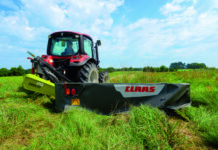Twenty years ago, CLAAS introduced the world’s first four-rotor swather, the LINER 3000. The design concept was to eliminate the swathing bottleneck, and allow the capacity of the forage harvesting convoy to be fully utilised.
Today’s four-rotor LINER 4000 and 3600 models remain a byword for productivity, forage quality, user convenience and reliability, Claas claim.
Brief harvesting windows call for top-performance harvesting equipment. With the LINER 3000, CLAAS engineers doubled the productivity of two-rotor swathers in the years following its introduction in 1999, so increasing the capacity of the entire harvesting chain. In just a single pass, the machine could swathe crops over a working width of up to 12.50 m into a single, uniform central swath. The box shape allowed optimum crop flow for the forage harvester following up behind. Farmers and contractors reported 30 percent higher productivity in the forage harvesting chain, thanks to higher chopping rates and less downtime.

The LINER 4000, with a working width of 15.50 m, was added to the range in 2009, and in 2011 the highly successful LINER 3000 was replaced with the LINER 3500, followed by the LINER 3600 in 2015. With working widths from 9.90 m to 15.50 m and swath widths from 1.20 m to 2.60 m, these machines adapt easily to different forage materials and all commonly used pick-ups. The silage tines specially developed by CLAAS, in combination with accurate rotor movement control, ensure clean and complete crop pick-up at all times, while protecting the ground beneath.
At the heart of every LINER is the rotor dome assembly that is permanently lubricated in an oil bath. All integrated tine arms are fitted with the patented PROFIX tine arm attachment system. The integrated predefined bending points are located outside the rotor dome. This ensures that the rotor dome components remain reliably protected at all times, resulting in low maintenance and a long service life.
The swather cam track is designed to withstand the heaviest loads, thanks to its graphite cast iron construction. The large diameter and gradual rise of the cam track ensures smooth-running tine arms and clean raking for long periods, with no material fatigue. The smooth movement of the cam rollers in all conditions also significantly boosts the components’ service life.
A sophisticated hydraulic folding mechanism is used to reduce the dimensions of the CLAAS LINER for road transport. Subject to individual country requirements, the machine can travel to the next work location at speeds of up to 50 km/h.
The road transport height remains less than 4.0 metres, without needing to get out of the cab or remove any tine arms.
The LINER 4000 and 3600 can be operated with the OPERATOR, COMMUNICATOR II or S10 terminals, as preferred. Thanks to the integrated ISOBUS functionality, CLAAS LINER machines can also be controlled with any other commercially available ISOBUS terminal if required. Altenatively, the innovative iPad-based control using the CLAAS EASY On Board App is the last word in user-friendly operation.
The control functions enable the machine operator to set the LINER precisely for the relevant ground and working conditions, and many settings can be stored in the memory and automated. The working width and swathing width, and also the rotor height are all infinitely variable via the comfort hydraulics system, for example. The headland clearance height can also be adjusted as required, allowing the machine to pass over even the highest forage crop volumes without affecting the swath shape.


![[Job Story] What farmers think about the new Claas Lexion combine harvester](https://www.heavyquipusa.com/wp-content/uploads/2020/05/Schermata-2020-05-04-alle-18.11.33-218x150.png)
 Copyright 2020 All rights reserved.
Copyright 2020 All rights reserved.